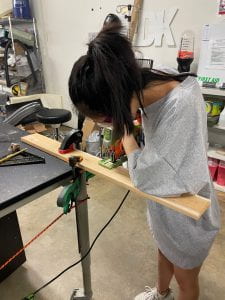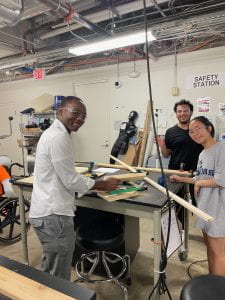My name is Gloria Ni, and I’m a freshman SEED intern majoring in Bioengineering with interests in engineering design, computer science, and applied mathematics. Welcome to my blog!
Walking into the conference room on the first day, I was surprised to see mostly unfamiliar faces. I immediately felt encouraged and intrigued by the initial conversations, having arrived early. After formal introductions and icebreaker activities, I was incredibly inspired by everyone’s diverse skills, interests, cultures, and experiences, and extremely excited to work alongside and learn from my colleagues.
After the Project Fair, I knew I wanted to work on the Ballard model. I felt galvanized by the potential impact of the device and the invaluable chance to build a device able to save and transform newborn lives.
Our team encountered our first challenge in deciding a team name. However, we persevered and conquered, ending with Team NIMBS, as we’re tasked with designing a Neonatal Instructional Model for Ballard Scoring. And of course, a team is never complete without a secret handshake (Team Handshake Video Demonstration)
With a color-coded To-Do List, our team dove straight into research on the Ballard method, as well as alternative methods for determining gestational age. We reached out and met with Alex Lammers, a former SEED intern who worked on the same project in 2019. He gave incredible insight into the needs finding, documentation, design specifications and feedback, as well as his experience in SEED. With a comprehensive list of over 30 questions, we later met with our client to clarify details regarding the users, environment, and practice of the Ballard assessment, in addition to the specifications and expectations regarding our project. Due to a slight miscommunication, our client joined the meeting an hour earlier than we had anticipated. Though we were prepared for the situation, this mishap taught our team the importance of being meticulous in our communication, especially regarding research on the international time difference. From the meeting, we gained a comprehensive understanding of the problem that we’re tasked with and the setting our device would be used in. With this new understanding, we again dove into research, looking into physical therapy instructional manikins, joint structures, puppets and humanoid robots, in addition to nursing education in Malawi, the background and history of introducing new technologies in Malawi, and standards for healthcare simulations.
Another challenge our team encountered was our team members’ lack of experience with CAD modeling. Since our prototype will inevitably require 3D modeled and printed parts, our team will need to learn and exercise these skills in the near future. An additional challenge our team encountered was that our client, who provides project specifications and our main form of contact with primary users, will not be in office for the next 2 weeks. However, we reached out to a Global Health 360 fellow who works closely with our user population to discuss how we can potentially connect with them in the meantime.
Furthermore, all interns participated in a Hand Tools Workshop, where we teamed up in groups of 3 to learn how to operate a jigsaw, handsaw, nail & hammer, clamp, drill, drill press, as well as various sanding devices and forms of glue, and employed these skills to create bat houses for donation. Wielding so many massive power tools felt extremely empowering, and I was grateful to further hone these skills, since my previous projects did not involve much woodworking.
Overall, I’m extremely grateful for the skills I’ve learned and exercised, in addition to the people I’ve had the privilege to work and interact with. I’m super excited to continue building our device and learning from my colleagues in the upcoming weeks!
I would like to conclude with a huge thank you and acknowledgement to fellow NIMBS teammates, Lam Nguyen and Andrew Sun; our client, Prince Mtenthaonga; 2019 design team member, Alex Lammers; our Design Supervisors, Shannon McGill and Alois Chipfurutse; and SEED/Rice 360 staff, Imari Fletcher, Dr. Deirdre Hunter, and Dr. Ashley Taylor. I’m extremely grateful that they made my experience this first week possible.


